|
Biederman
Motors Corporation in World War Two
Cincinnati, OH
1920-1955
This page updated 10-12-2023.
The Biederman Motors Corporation was founded
on the industrial west side of Cincinnati, OH in 1920 by Charles and
Fred Biederman. Charles Biederman became president and chief
engineer, and Fred Biederman took on the role of secretary of the new
company. Biederman Motors built small lots of specialized trucks
out of two buildings on Barnard Street in Cincinnati. It was a
small job shop with no moving assembly line that the larger truck
companies in the industry were moving to at the time.
There are excellent histories available
in several books that tell the story of Biederman Motors during its 35
years of operation. However, as is the case with many corporate
histories, the World War years have been overlooked. Much of this
is due to the fact that the company did not produce any trucks that were accepted by Army Ordnance for
use by the United States Army.
These records are well documented. Instead, Biederman Motors
produced 1,638 7-1/2-ton 6x6 trucks for the United States Army Air
Forces (USAAF) during World War Two. Records of trucks built by
any truck company for the USAAF are not readily available. With
documents furnished by Jeff Lakaszcyck, I have been able to publish this
long overdue recognition of how the Biederman Motors Corporation helped
win World War Two.
Location: To date, the historical
record has been unclear as to the location of Biederman Motors in
Cincinnati, OH. In reality, there has been more speculation by
historians as to what occupied the former Biederman Motors plant than
where it was located to begin with. Some references indicate that
Cincinnati's largest Chevrolet dealership in the late 1950s took over
the location, while others say that it was a tool and die shop.
The largest Chevrolet dealership during Biederman's
existence was Queen City Chevrolet. The
original location of Queen City Chevrolet was at 6th and Sycamore in
Cincinnati. Later it moved to 414 East Court Street, which is on
the east side of downtown Cincinnati. During the 1950s and early
1960s this was a good location for a car dealership. Once the
interstates arrived and suburban sprawl set in, this was no longer
ideal, and the dealership does not exist today. Today its former location is a
casino.
The 1943 Cincinnati city directory listing
below shows Biederman Motors Corporation at 2131 Spring Grove Avenue, which is west of downtown
Cincinnati in an industrialized area. It is located east of the Cincinnati
rail yards and one mile north of Union Terminal Train Station. After Biederman closed up shop, the old factory would
have been better suited for a machine
shop than a car dealership.

This is the entry for Biederman Motors Corporation in the 1943
Cincinnati city directory. Image courtesy of the Cincinnati
Library.
Below are three Sanborn maps showing the Biederman factory complex. Each map shows a smaller area with
Biederman in the lower right hand corner. The actual date of the
first three maps is unknown. The map originated in 1900 and is
probably pre-World War Two.
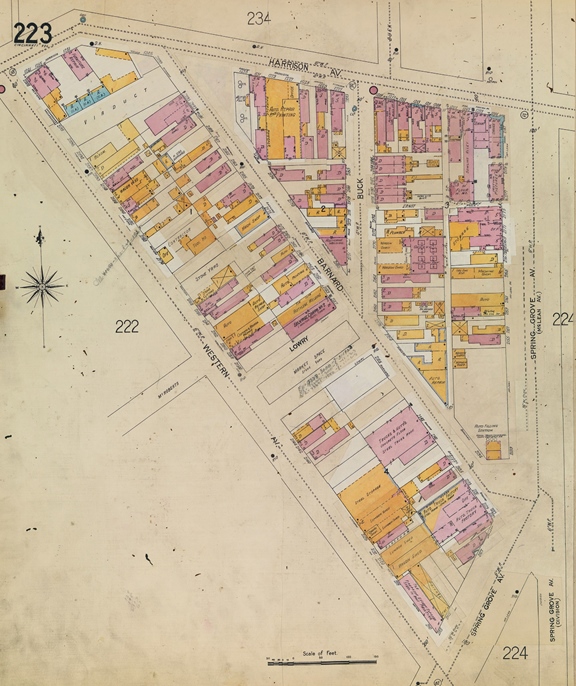
This area is bounded by Harrison on
the north and Spring Grove Avenue to the south and east. Biederman
is in the south-east corner of the map. The map began in 1900 and
had continuing changes made to it. The exact date of this image is
unknown. Image courtesy of the Cincinnati Library.
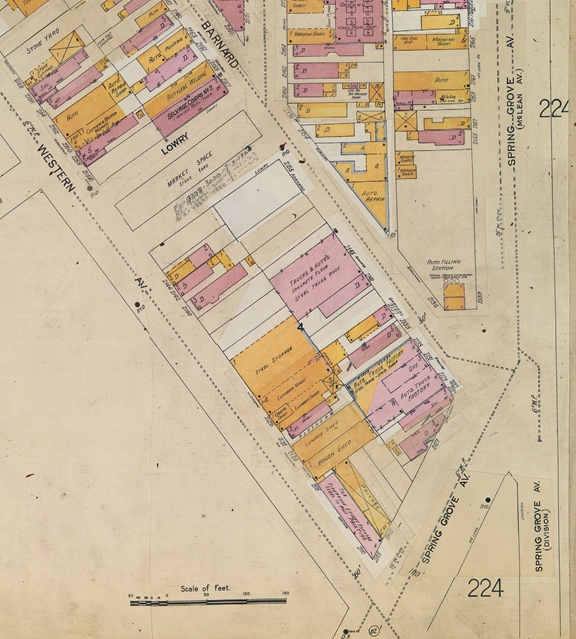
This image shows several truck related
buildings that encompass the Biederman truck complex. The auto
truck factory is actually located at 2131 Barnard Street, not Spring Grove as
noted in the 1943 city directory. Today, Barnard Street no longer
exists. Image courtesy of the
Cincinnati Library.
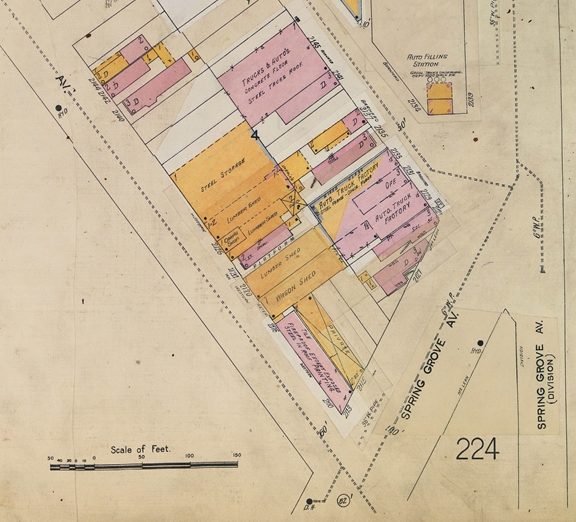
This image shows the Biederman complex with an auto
truck factory and office at 2131 Barnard Street. It is
approximately 75 feet along Barnard and 100 feet deep. The truck and auto building
at 2145 Barnard is about the same size with several other buildings for
storage. Because there is a wood storage building in the group,
this would imply the date of the map was when Biederman was still using
wood in its cabs. During World War Two, the Biederman Motor
Corporation could produce just over six trucks per week from this location. Image courtesy of the Cincinnati
Library.
In looking at the map, the corner of the
complex could actually be at 2131 Spring Grove. It would make
sense for Biederman to use a Spring Grove address as it was and is a
well-known, major thoroughfare in Cincinnati. In any event, the location of the
factory has been found.
Below is a current Google Maps satellite image
of the same area 80-100 years later than the maps above. A lot has
changed. Barnard Street no longer exists. Praxair and Cemendine
Automotive now occupy the area where Biederman was located.
I-75/I-74 is now just to the east of Spring Grove Avenue, which no
longer has the southwest split shown on the Sanborn map.
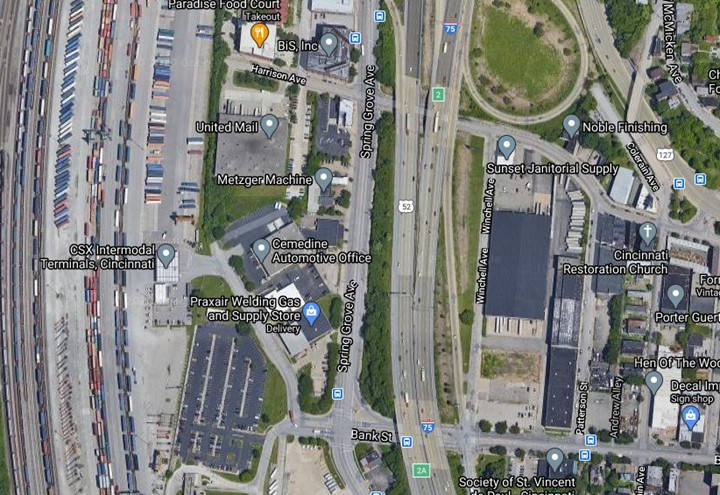
Image courtesy of Google Maps.
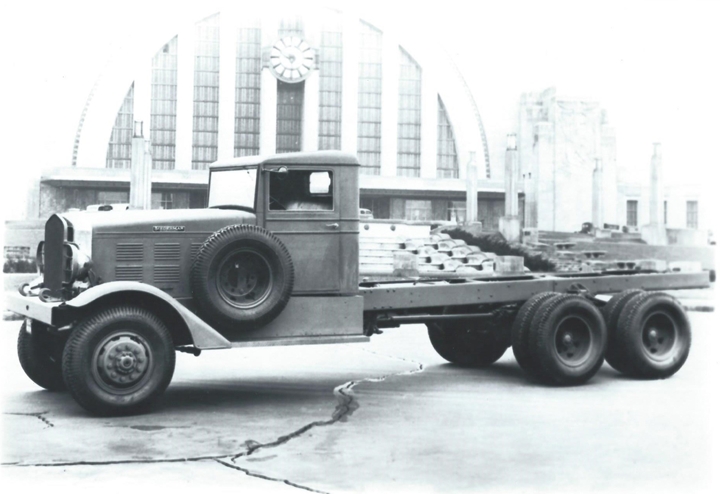
This 1935 Biederman Model N was photographed
in front of the Cincinnati Union Terminal. When the company
developed a new model and wanted a photo of it for advertising and
publicity, it was an easy one mile drive from the factory to Union
Terminal. This was the prototype of a small 1936 order for Army
Air Corps fuel trucks with a 3,000 gallon Heil tank installed. The
Model N was called the "Neverstall" by Biederman. Photo
courtesy of John Vannatta via Jeff Lakaszcyck.
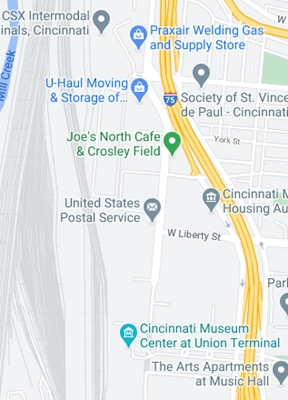
This Google Maps image shows that Praxair, at the location of
the former Biederman truck factory, was a straight shot north of the
Cincinnati Union Terminal. They were about a mile apart.

The year is 1941 and the U.S. Army put on a
huge exercise now known as the Louisiana Maneuvers. The Louisiana
Maneuvers covered 3,400 square miles of which much was done off military
reservations and on public roads. Here some of the 400,000 troops
involved are being transported on 1936 Biederman Model 110 6x6 trucks
being used as artillery prime movers. Image courtesy of Jeff Lakaszcyck
added 10-12-2023.
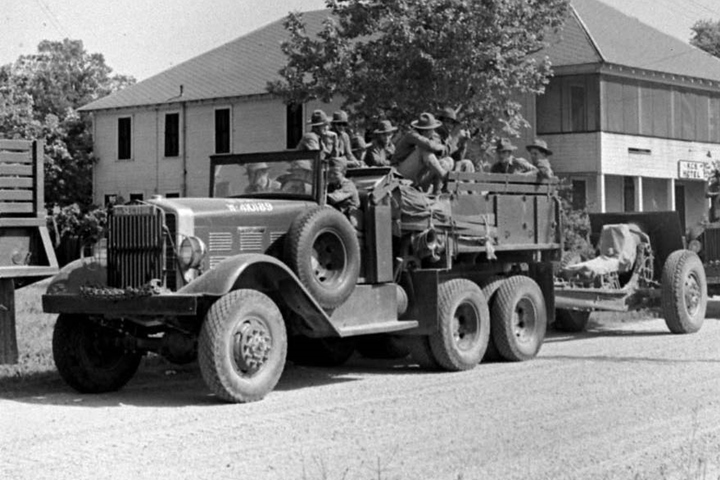
Image courtesy of Jeff Lakaszcyck added
10-12-2023.
Biederman Motors Corporation
World
War
Two
Production:
During World War Two the United States Army Air Forces awarded
the Biederman Motors Corporation 18 major contracts valued at
$12,844,000. $12,018,000, or 94% of the company's contracts was
for trucks. The remaining $826,000 or 6% was for truck parts,
airplane engine parts and crankshafts, connecting rod bearings, and
gasoline engine assemblies. The company built three different types of 7-1/2-ton 6x6 heavy duty
trucks for the United States Army Air Forces totaling 1,636 units.
The average cost for each truck was $7,337.
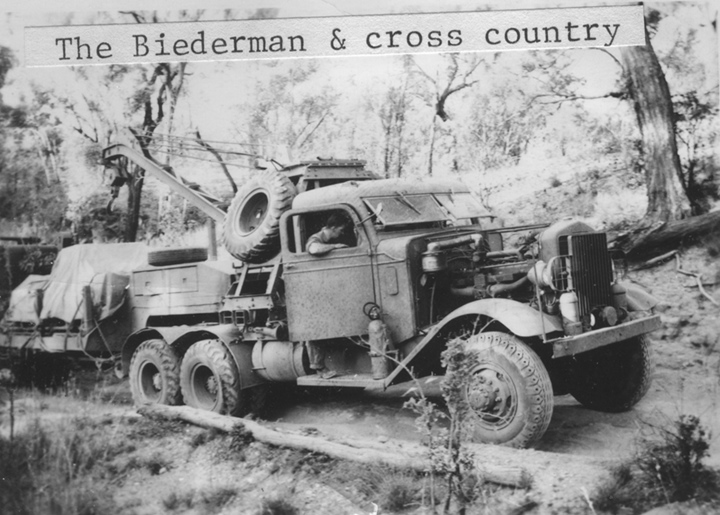
This is the only known photo of a Biederman
C-2 wrecker in use in a combat zone during World War Two. This
photo was taken by SGT. John Francis Sullivan, 32nd Infantry Division,
from Janesville, Wisconsin at Cape York in Australia during 1942.
The photo is courtesy of his son, Mr. Brian Phelps. Photo added
10-10-2023.
What makes this photo even
more amazing and historically significant is that Biederman only built
twelve C-2s during World War Two. I want to thank Mr. Phelps of
sharing the photo for use on this website.
This is what SGT
Sullivan wrote about this photo: "After landing at Sydney and
a short stay there and subsequently at Melbourne, I was sent to join the
8th Air Corps Material Squadron at an inland village; Charleville,
Queensland. This unit was soon to move north and it fell upon me, the
junior jackass of the squadron to command a detachment that was to move
across open country with the heavy equipment. No roads, few villages and
wild country. Except for the lack of Indians, it was Lewis and Clarke
all the way. Arriving at Townsville, I was attached to the 5th
Australian Infantry Division to make an exploratory trek of three
hundred miles up the Cape of York. This was a primitive area inhabited
only by aborigines. The large mound above is an ant hill. A picture
similar to this appeared in Life magazine. The commercial garage picture
contains in small print a by line 'monkey glands for motorsólimp in an
leap out'. At that time, monkey glands were looked to by some as a
way of regaining a lost youth."
Table 1 - Biederman Motor
Corporation's
Major World War Two Contracts
The information below
comes from the "Alphabetical Listing of Major War Supply
Contracts, June 1940 through September 1945." This was
published by the Civilian Production Administration,
Industrial Statistics Division. Table added 10-10-2023. |
|
Product |
Contract Number |
Contract Amount |
Contract Awarded
|
Completion
Date |
| Tractors Trucks -
USAAF |
535-AC-15291 |
$125,000 |
6-1940 |
12-1940 |
| Tractors Truck -
USAAF |
535-AC-16392 |
$93,000 |
11-1940 |
4-1941 |
| Tractor Trucks -
USAAF |
535-AC-17394 |
$348,000 |
1-1941 |
11-1941 |
| Tractors Truck -
USAAF |
535-AC-19618 |
$338,000 |
6-1941 |
10-1941 |
| Tractor Trucks -
USAAF |
535-AC-22377 |
$1,952,000 |
11-1941 |
10-1942 |
| Tractors Truck -
USAAF |
535-AC-27791 |
$4,532,000 |
5-1942 |
11-1943 |
| Truck Tractor
Parts - USAAF |
20017-AC-499 |
$77,000 |
10-1943 |
9-1944 |
| Trucks - USAAF |
20017-AC-679 |
$2,361,000 |
1-1944 |
1-1945 |
| Airplane
Crankshafts - USAAF |
33038-AC-5974 |
$95,000 |
11-1944 |
5-1945 |
| Motor Vehicle
Parts - USAAF |
33038-AC-7576 |
$57,000 |
1-1945 |
7-1945 |
| Wrecking Truck
Parts - USAAF |
33038-AC-7146 |
$82,000 |
1-1945 |
10-1945 |
| Conn Rod Bearings
- USAAF |
33038-AC-7882 |
$61,000 |
1-1945 |
3-1945 |
| Gasoline Engine
Assys - USAAF |
33038-AC-8691 |
$167,000 |
2-1945 |
12-1945 |
| Trucks - USAAF |
33038-AC-8434 |
$2,269,000 |
2-1945 |
4-1946 |
| Airplane Engine
Parts - USAAF |
33038-AC-9994 |
$54,000 |
4-1945 |
2-1946 |
| Crankshafts -
USAAF |
33038-AC-10256 |
$118,000 |
4-1945 |
5-1947 |
| Wrecker Kits -
USAAF |
33038-AC-9508 |
$55,000 |
4-1945 |
10-1945 |
| Motor Vehicle
Parts - USAAF |
33038-AC-10127 |
$60,000 |
5-1945 |
12-1945 |
|
Total |
|
$12,844,000 |
|
|
|
Table 2 - Biederman Motors Corporation World War Two Truck
Production |
|
Type |
Number Built |
Comments |
| F-1
Fuel Tractor |
1,011 |
From
Table 3 |
| C-2
Wrecker |
12 |
From
Table 4 |
| P-1
Crane Truck |
613 |
Estimated - See P-1 section below |
|
Total |
1,636 |
|
F-1 Fuel Tractor:
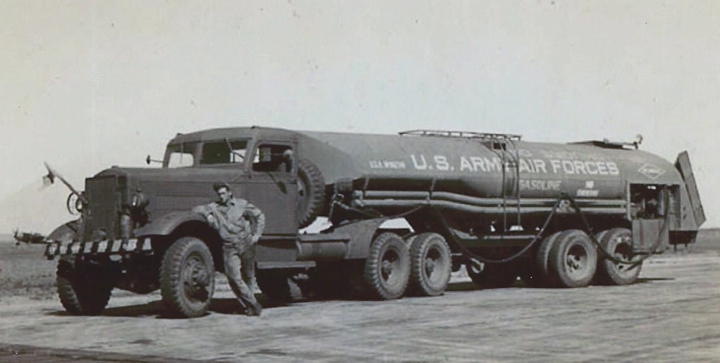
This is a Biederman F-1 Tractor with an F1A 4,000 gallon fuel
trailer. Photo courtesy
of John Vannatta via Jeff Lakaszcyck.
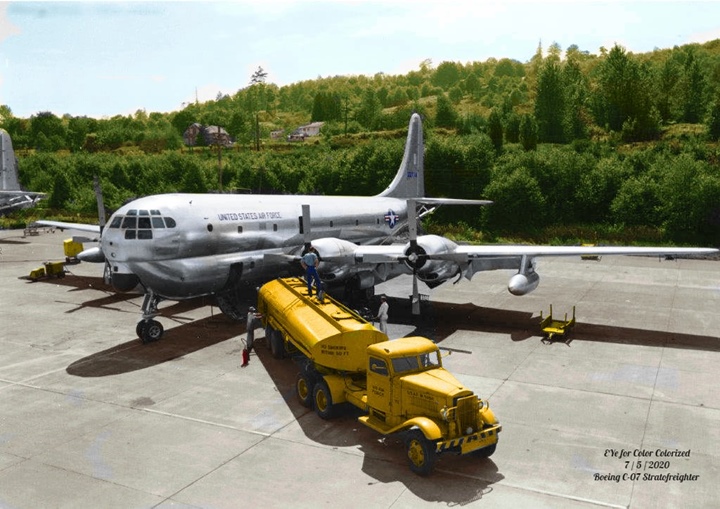
This colorized photo shows a post-World War
Two era KC-97 being refueled by a Biederman F-1. George Murphey
colorization image courtesy of Jeff Lakaszcyck added 10-10-2023.
As noted above, Biederman Motors did not
produce trucks that were accepted and recorded by Army Ordnance in
"Summary Report of Acceptances, Tank-Automotive Material, 1940-1945."
The information used to determine the number of F-1 and C-2 trucks built
by Biederman during World War Two came from Documents 1 and 2 shown below.
These were furnished by Jeff Lakaszcyck.
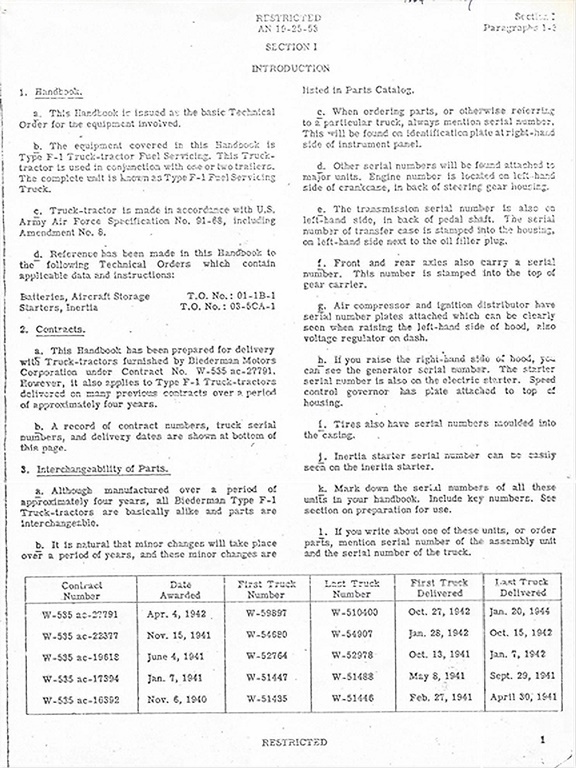
Document 1: The information at the
bottom of this document is used in Table 3 below.
Table 3 - Biederman Type F-1 Truck Contract Information
From: AN-19-25-53, Handbook and Technical Order for the
Truck-Tractor and
From: Table 1 |
|
Contract Number |
Date Awarded |
USA Numbers |
Delivery Dates |
Number in Contract |
Contract Amount |
Cost Per Truck |
|
W-535-AC-16392 |
11-6-1940 |
W51435 - W51446 Inclusive |
2-27-1941 to 4-30-1941 |
12 |
$93,000 |
$7,750 |
| W-535-AC-17394 |
1-7-1941 |
W51447 - W51488 Inclusive |
5-8-1941 to 9-29-1941 |
42 |
$348,000 |
$8,286 |
| W-535-AC-19618 |
6-4-1941 |
W52764 - W52978 Inclusive |
10-13-1941 to 1-7-1942 |
215 |
$338,000 |
$1,572* |
|
W-535-AC-22377 |
11-15-1941 |
W54680 - W54907 Inclusive |
1-28-1942 to 10-15-1942 |
228 |
$1,952,000 |
$8,561 |
| W-535-AC-27791 |
4-4-1942 |
W59897 - W510400 Inclusive |
10-27-1942 to 1-20-1944 |
504 |
$4,532,000 |
$8,992 |
| |
|
|
Total |
1,011 |
|
|
*This cost is out of line with the other
contracts for this vehicle. It is unknown why this figure is so
much lower than the other cost per truck per contract.
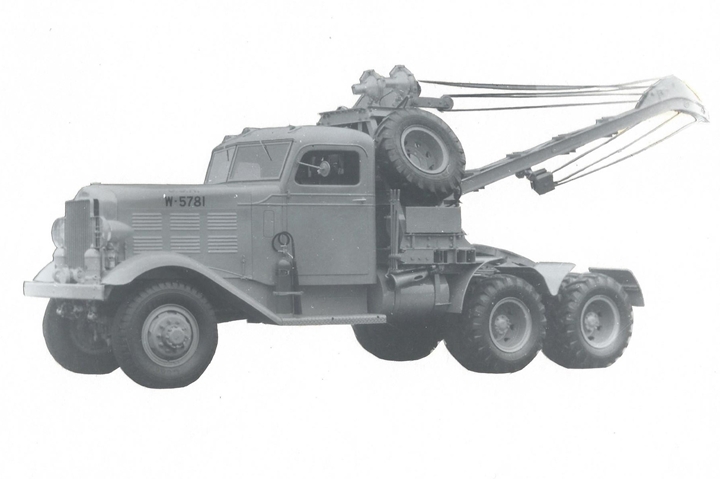
This is the first of twelve C-2 wreckers
that Biederman built for the USAAF. Photo courtesy of John
Vannatta via Jeff Lakaszcyck.
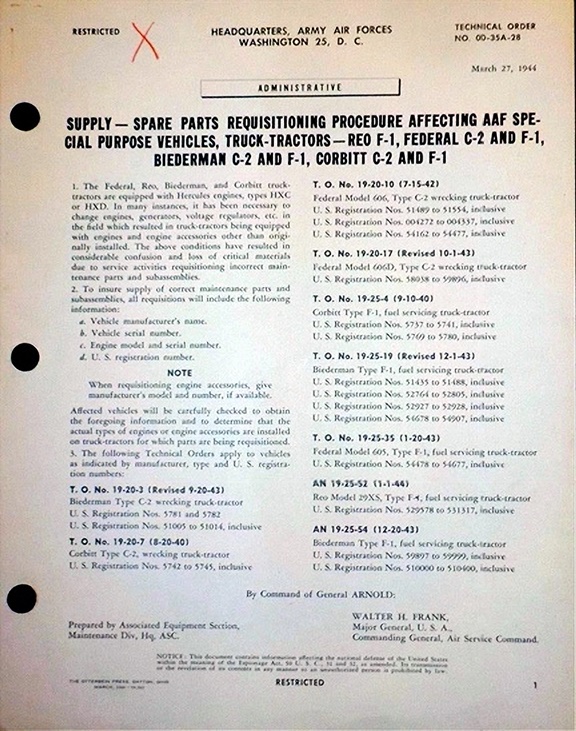
Document 2: T.O. No. 19-20-3 (Revised
9-20-43) provides the U.S. Registration numbers for the Biederman-built
C-2 wreckers. This information is used in Table 4 below.

I have shown this photo a second time.
This photo was taken in 1942 in Australia. Therefore, this
Biederman would have been built early in the war. As the second
through fifth contracts were for the F-1 tractor, this leaves the first
major contract in Table 1, contract number 535-AC-15291 dated 6-1940 as
the only logical choice for the C-2 wrecker contract. This
information is shown in Table 4 below. SGT. John Francis Sullivan
photo via Brian Phelps added 10-10-2023.
Table 4 - Biederman Type C-2 Truck Contract Information
From: Technical Order No. 00-35A-28 Dated March 27, 1944
and
From: Table 1 |
|
Contract Number |
Date Awarded |
USA Numbers |
Delivery Dates |
Number in Contract |
Contract Amount |
Cost Per Truck |
|
535-AC-15291 |
6-1940 |
W5781-5782 Inclusive and W51005
- W51014 Inclusive |
6-1940
to 12-1940 |
12 |
$125,000 |
$10,417 |
| |
Total |
|
|
12 |
|
|
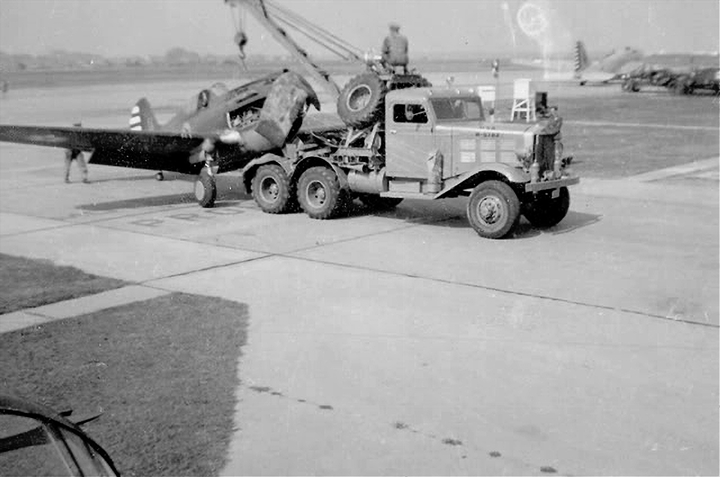
This pre-September 1942 photo shows
Biederman C-2 with USA registration number W-5782 towing a damaged
P-40 at an airfield in the United States. Until September 12,
1942, the USAAF painted the rudders of its aircraft with alternating
red and white stripes with a blue border. Image courtesy of
Jeff Lakaszcyck added 10-12-2023.
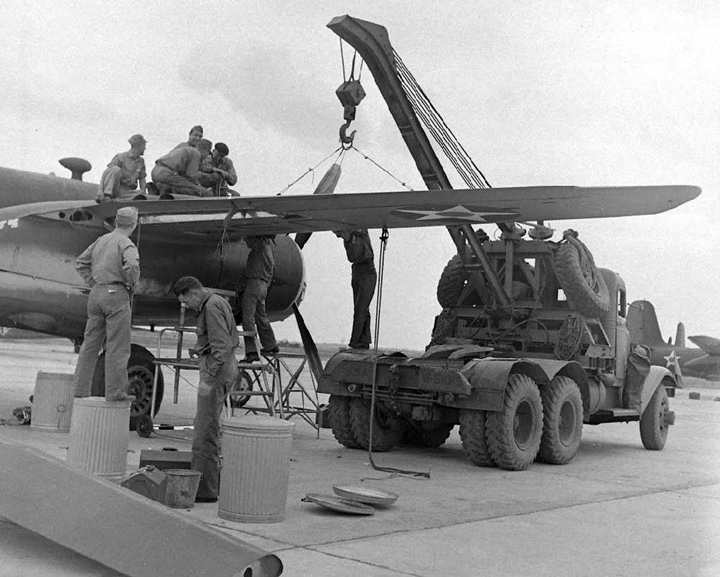
In this photo, Biederman C-2 USA
registration number W-51013 is removing or installing the outer wing on
a Martin B-26 Marauder. Of special interest is the airman
standing on a trash can to obtain a better view of the work being done.
Image courtesy of WWII Radio Facebook via Jeff Lakaszcyck added
10-12-2023.
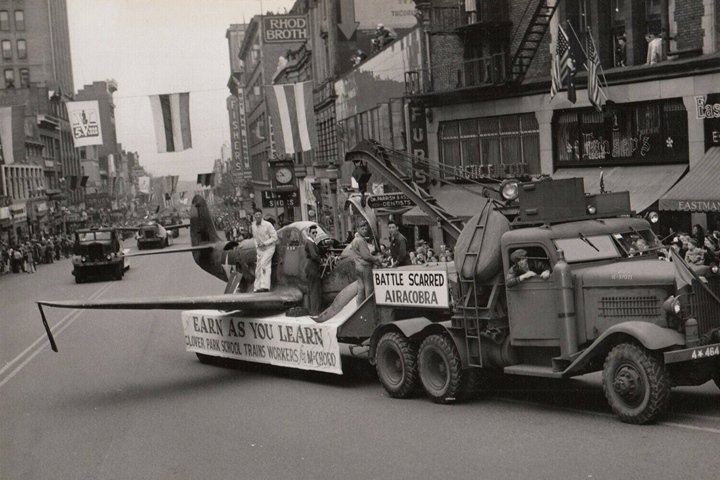
Biederman C-2 USA registration number
W-51011 from McChord Field in Tacoma, WA is towing a P-39 during a World
War Two parade. Image courtesy of Andre Margage's Facebook posting via Jeff Lakaszcyck
added 10-12-2023.
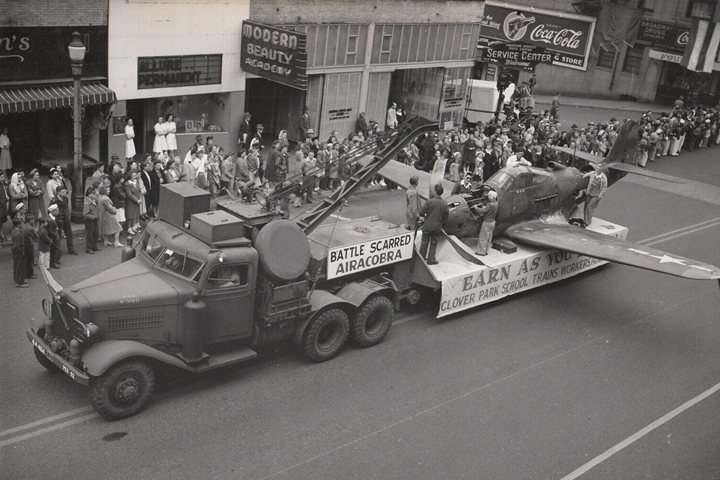
Image courtesy of Andre Margage Facebook via
Jeff Lakaszcyck added 10-12-2023.
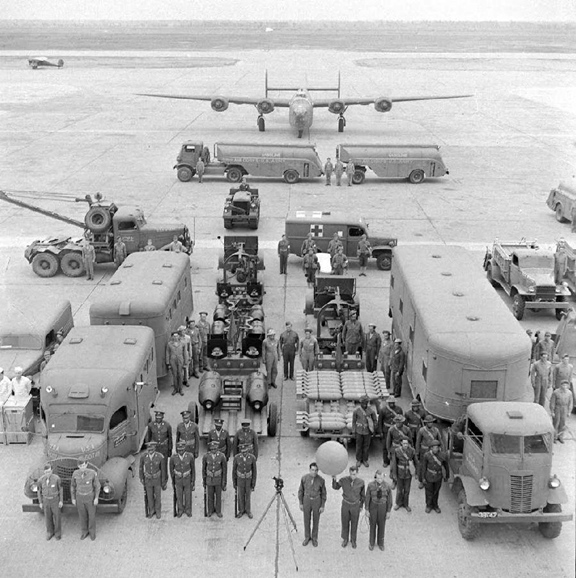
A Biederman C-2 wrecker is among the several
World War Two trucks and trailers in this photo. This photo is
also significant because it demonstrates the segregated
nature of the United States Army Air Force during World War Two.
The U.S. 1940 Selective Training and Service Act required the United
States military to accept African-American into the military on a
proportional basis with white airmen. This forced the Army Air
Force to finally accept African-Americans into its ranks. However,
this photo shows the highly segregated nature of their service once they
were in the Army Air Force. The African-Americans are separated
from the white airmen by the trailers on either side of them. In
the center of the group is their white officer. One of the largest
hypocrisies of the United States during World War Two was that it was
freeing the world from tyranny with a segregated military. Image
courtesy of WWII Radio Facebook via Jeff Lakaszcyck added 10-12-2023.
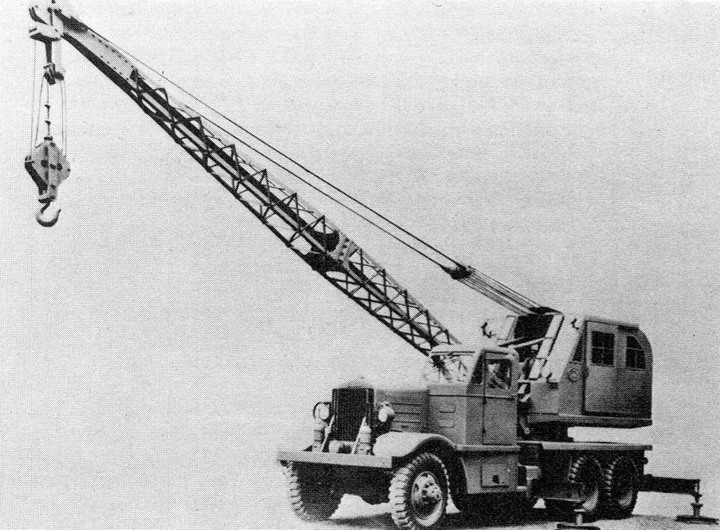
The last type of truck Biederman built for
the war effort was the P-1 crane truck. The P-1 had a half cab for
the driver and carried a Michigan TM-16 10-ton crane. Note that
the cab has been moved over what on the F-1 and C-2 was the driver's
side running board.
There are no known records of USA nor serial
numbers of the Biederman P-1 crane truck to establish how many the company
built. The company was still building the P-1 as of 7-30-1945,
which was USA number W00113942. Production most likely continued
for another week until the stop order arrived with the end of
hostilities in early August.
In looking at the number of F-1 refueling
tractors built on contract W-535-AC- 27791, Biederman turned out an
average of 33.6 units per month over 15
months. This is an annual rate of 403.
Assuming that Biederman continued at the same
run rate for the P-1 crane truck, that production started in March 1944,
and ended after one week in August 1945, the company produced an
estimated 638 P-1 crane trucks during 18.25 months of production.
|
Table 5 - Biederman P-1 Truck Production |
| Number Built |
Comments |
| 638 |
From estimate
above |
Table 6 below is similar to Tables 3 and 4
above. However, Table 6 is incomplete because there is no known
information available for either the USA numbers or the number per
vehicles in each contract. Contract 33038-AC-8434 had an end date
of 4-1946. This may well have been the originally predicted end of
production for the contract. It would be unlikely that production
would have actually continued after August 1945.
However, one can do a reality check on the
estimated 638 number of P-1s that I calculated. Doing this, the
average truck cost comes out to $7,258. While a little lower than
the previous costs, it is still reasonable.
This assumes the Michigan Power Shovel TM-16s were Government Furnished
Equipment.
Table 6 - Biederman Type P-1 Truck Contract Information
From: Table 1 |
|
Contract Number |
Date Awarded |
USA Numbers |
Delivery Dates |
Number in Contract |
Contract Amount |
Cost Per Truck |
|
20017-AC-679 |
1-1944 |
|
1-1944
to 1-1945 |
|
$2,361,000 |
|
|
33038-AC-8434 |
2-1945 |
|
2-1945 to 4-1946 |
|
$2,269,000 |
|
| |
Total |
|
|
638 Estimated |
$4,630,000 |
$7,258 Estimated |
Excerpts from:
"Handbook of Instructions with Parts Catalog for Model P-1 Mobile Truck
Crane:" Because the Biederman-built P-1 Mobile Truck Crane is
such an unknown vehicle, I have included the following pages from the
manual to give the reader a more in-depth understanding of this truck.
This is T. O. No. 19-40-12 dated 5 March 1945. All of these images
were added 10-10-2023.
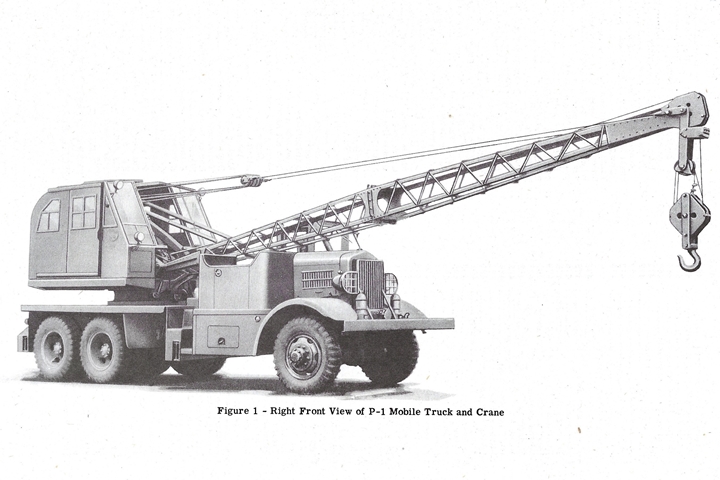
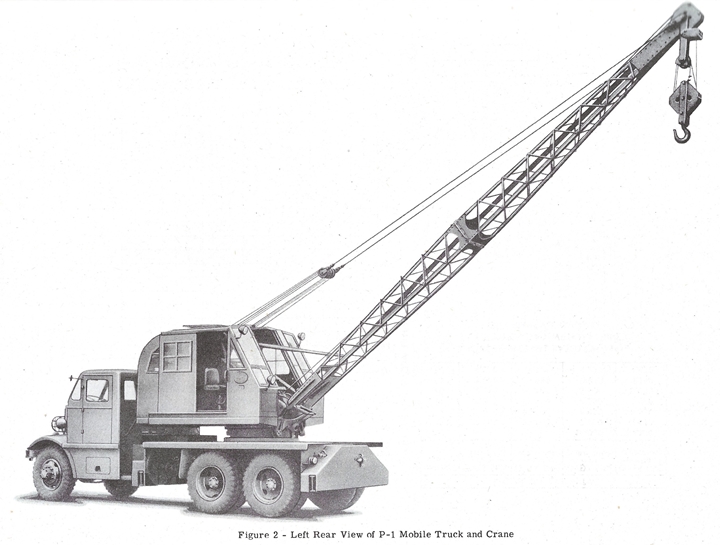
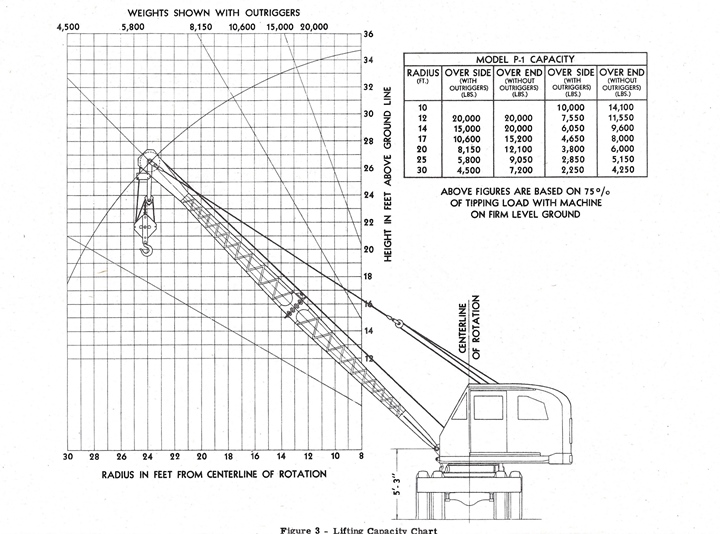
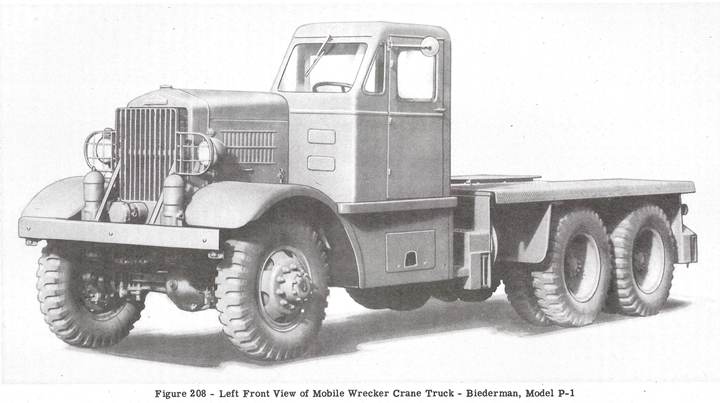
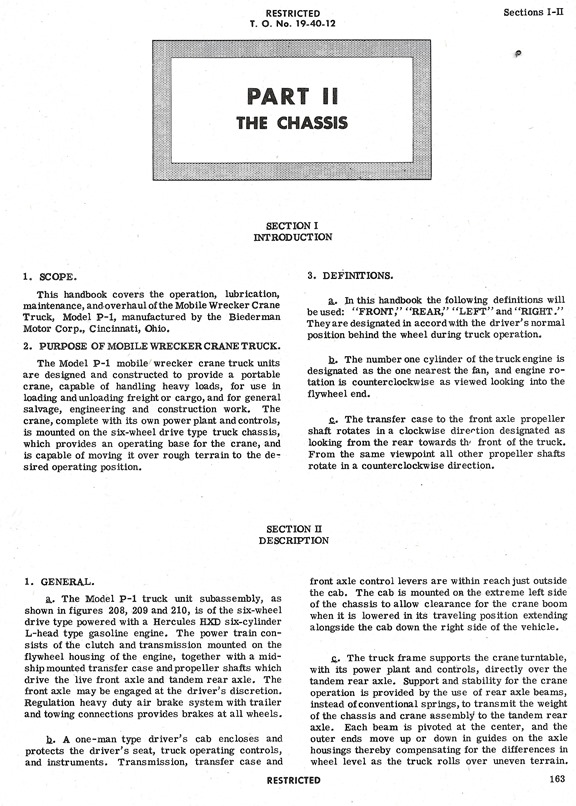
Paragraph b notes that the driver's cab is
not big enough to include the transmission, transfer, and front axle
control levers which are outside of the cab. This can be seen in
the next-to-last image in this section.
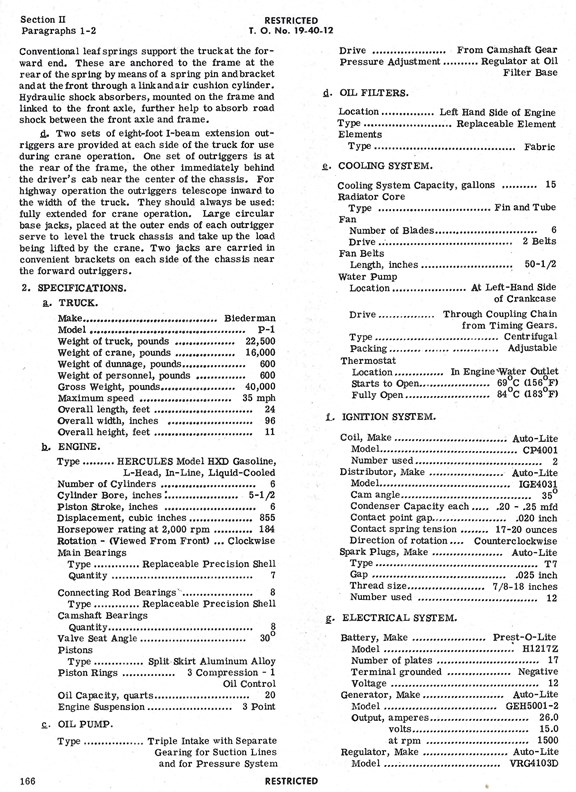
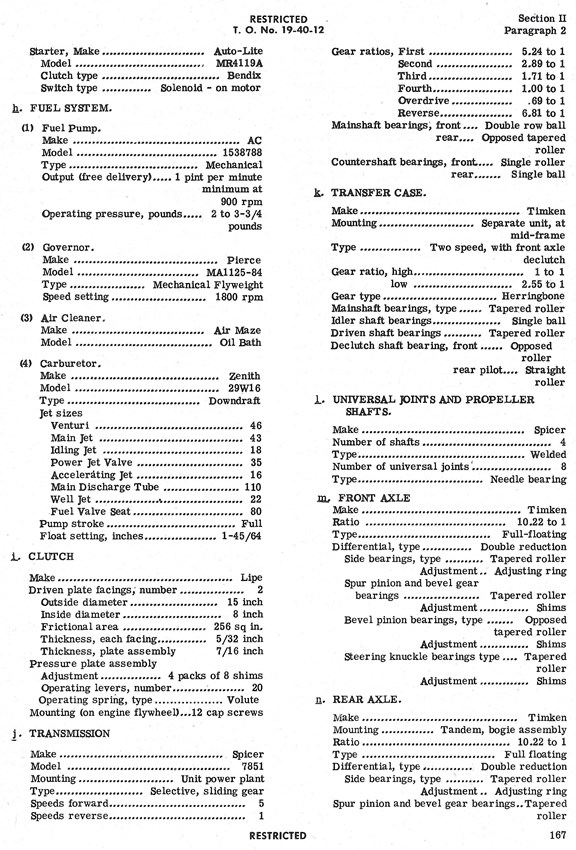
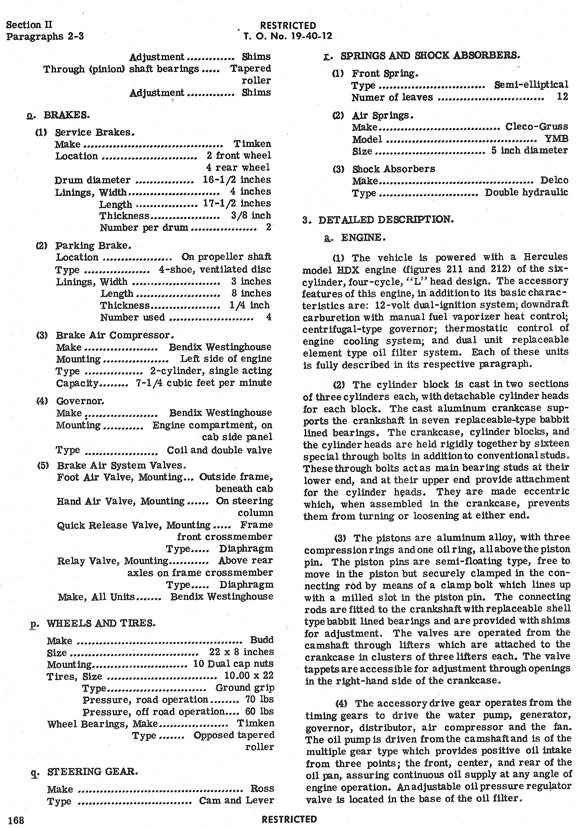
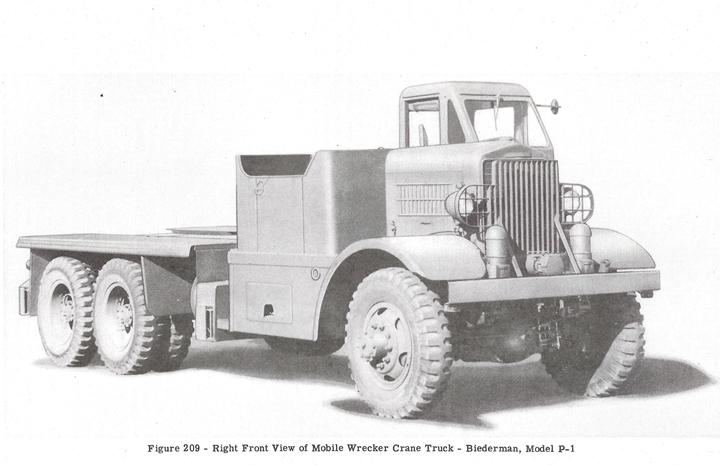
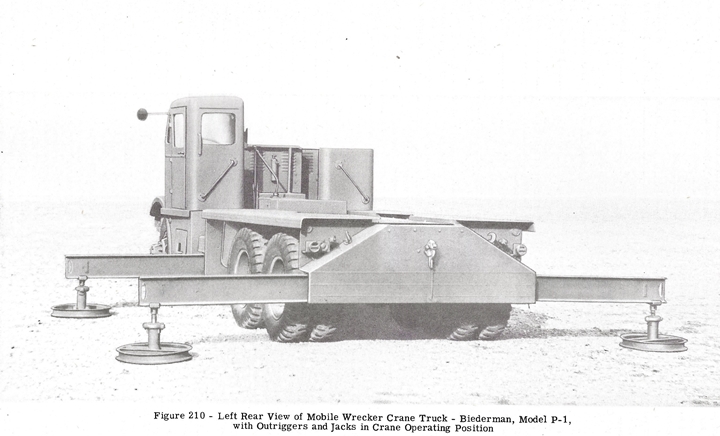
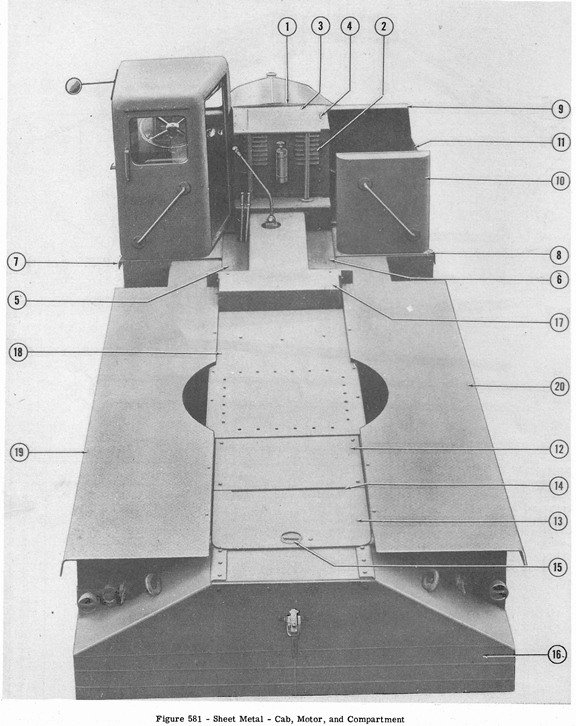
This image shows that the transmission, transfer,
and front axle control levers are outside the cab as noted above.
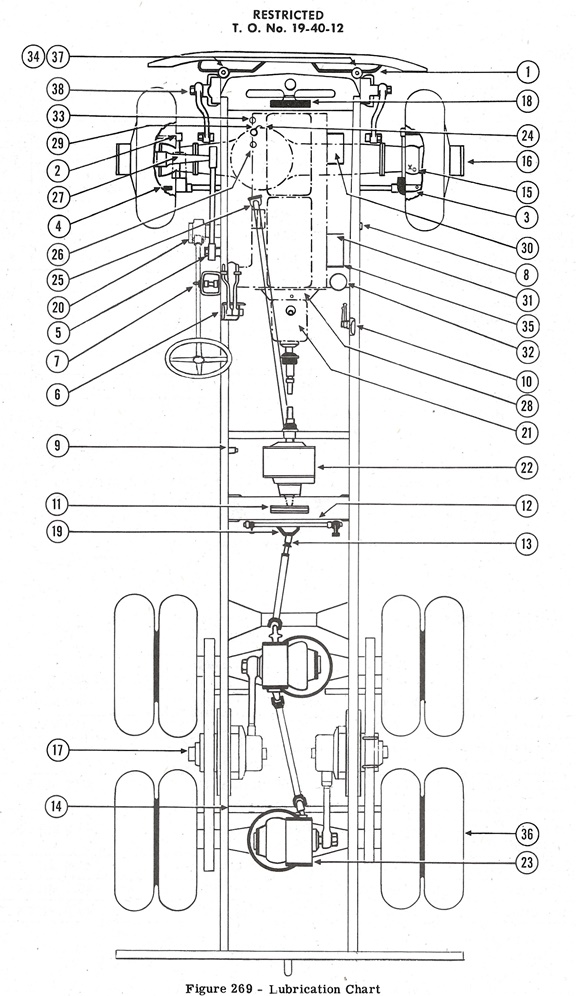
Other P-1 Information:
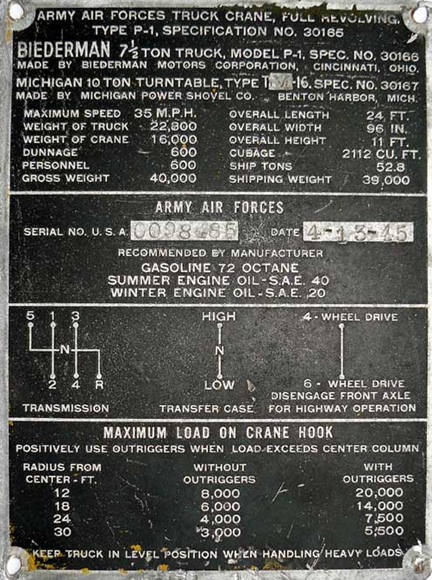
This Biederman P-1 data plate has a
USA number of 0098*85 and was built on 4-13-1945. The
information at the top of the data plate shows that the P-1s were
built for the Army Air Forces and were built by Biederman.
Photo courtesy of Jeff Lakaszcyck.
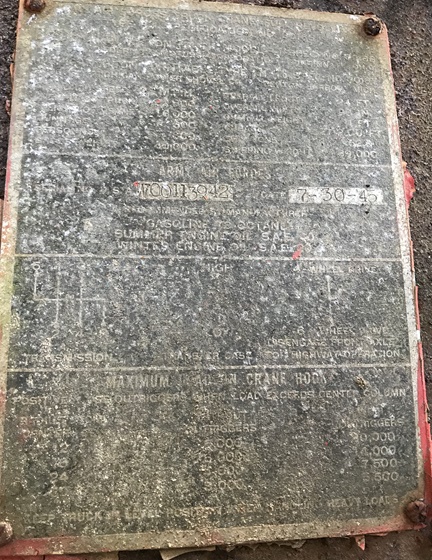
This 7-30-1945 dated data plate has a USA
serial number of W00113842. Photo courtesy of Jeff Lakaszcyck.
Survivors: Currently, there are
about a dozen Biederman World War Two era 7-1/2-ton 6x6 trucks that are known to exist worldwide.
This number includes both the F-1 fueling tractor and the P-1 crane
truck. None of the twelve Biederman-built
C-2s are known to exist.
F-1 Fuel Tractors: When this page was first published in
October 2020, there were no restored Biederman trucks. That has
changed with the restoration in England of the F-1 fuel tractor shown in
the photos below.
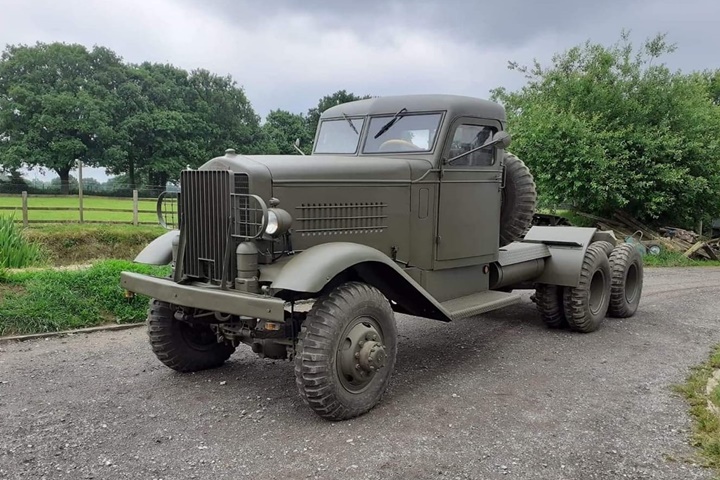
This restored Biederman F-1 tractor is owned
by
Ian
Hughes in England. Ian Hughes
photo via Jeff Lakaszcyck added 10-10-2023.
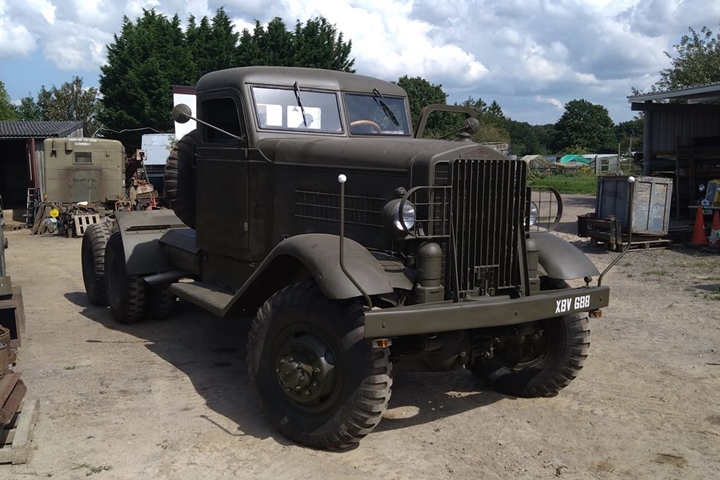
This is
also Ian Hughes' F-1 fuel truck at a later stage of the restoration.
Chris Barton
photo via Jeff Lakaszcyck added
10-10-2023.
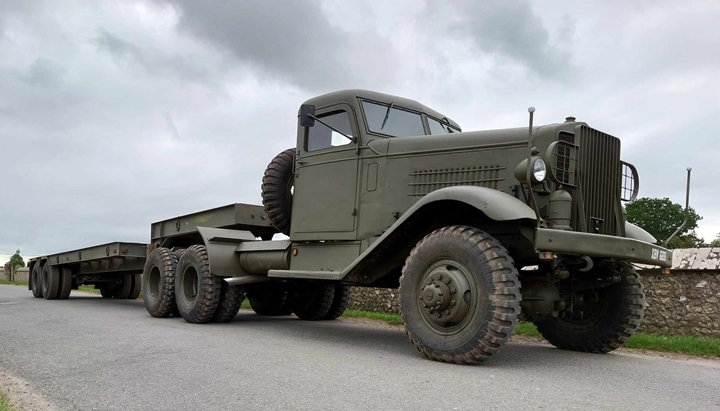
This and the next three images show Ian
Hughes' Biederman F-1 out on a road trip in rural England.
Depending on the perspective of these photos, the F-1 in the
last two photos appears to take to up most of the roadway. I had the
privilege in 2008 to drive some of the rural roads near Duxford, England
and found them to be rather narrow. I found this especially true
when there was a large tour bus coming in the opposite direction.
I ended up scraping the side of the car in the hedges along the side of
the road to make sure I did not end up as a hood ornament on the bus.
Mick Wilson photo via Jeff Lakaszcyck added 10-10-2023.
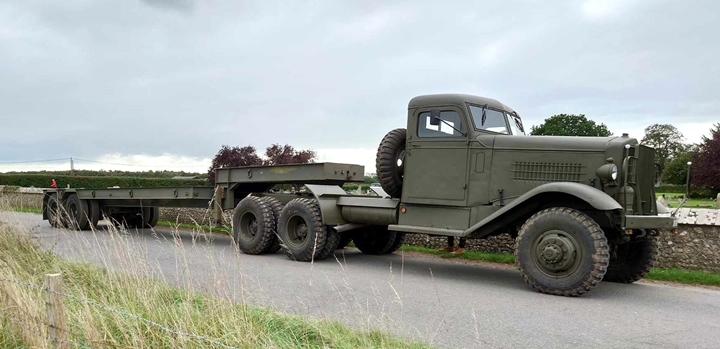
Mick Wilson photo via Jeff Lakaszcyck added
10-10-2023.
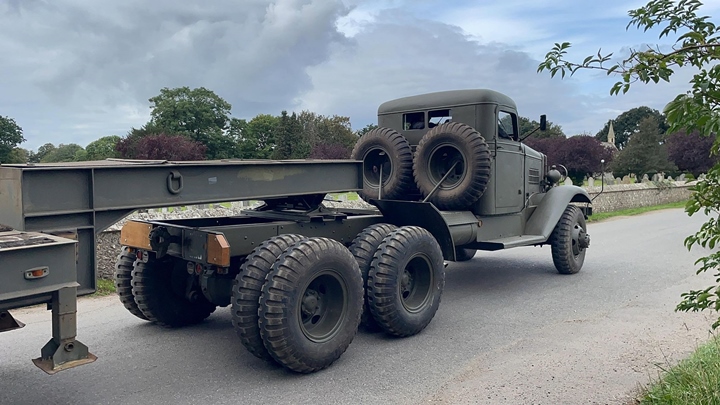
Mick Wilson photo via Jeff Lakaszcyck added
10-10-2023.
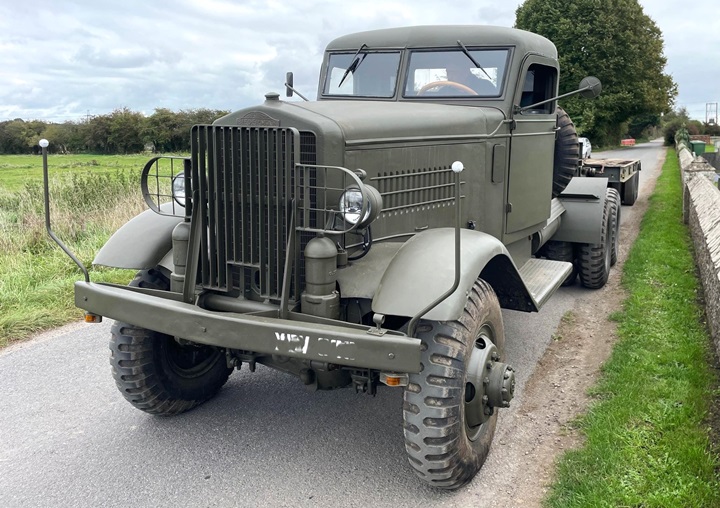
Mick Wilson photo via Jeff Lakaszcyck added
10-10-2023.
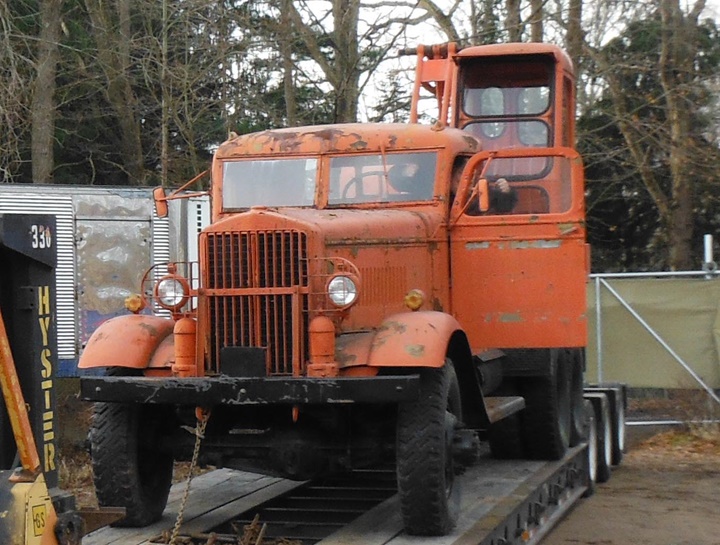
This 1944 F-1 fuel tractor was converted into
a
crane truck by a post-World War Two owner and is now owned by Ken Ochenkowski.
It is currently being restored to its original World War Two
F-1 configuration. Photo courtesy of Jeff Lakaszcyck.
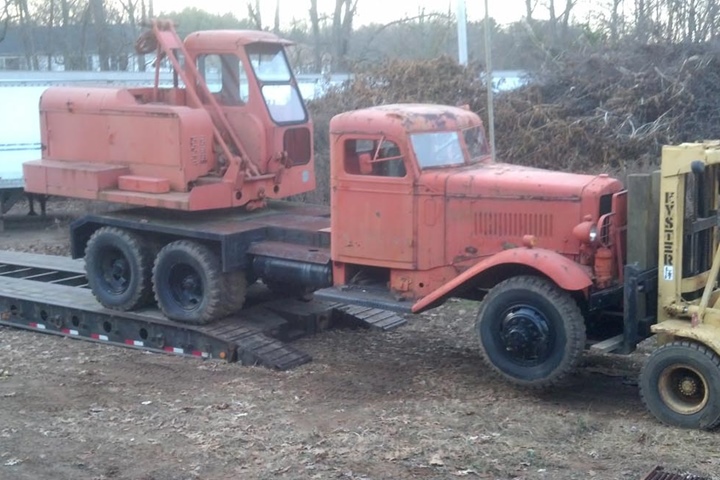
In this photo of the F-1 with the crane
added, the truck has a reddish hue rather than the orange in the above
photo. Photo courtesy of Jeff Lakaszcyck.
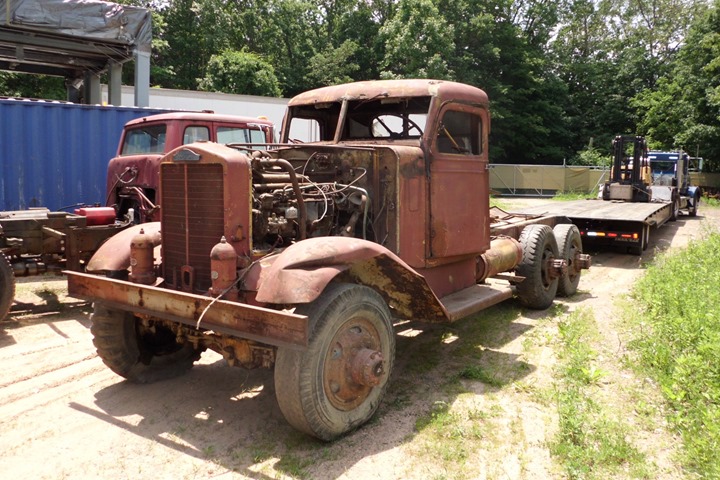
This second 1944 Biederman F-1 is also owned by Ken Ochenkowski. Photo courtesy of Jeff Lakaszcyck.
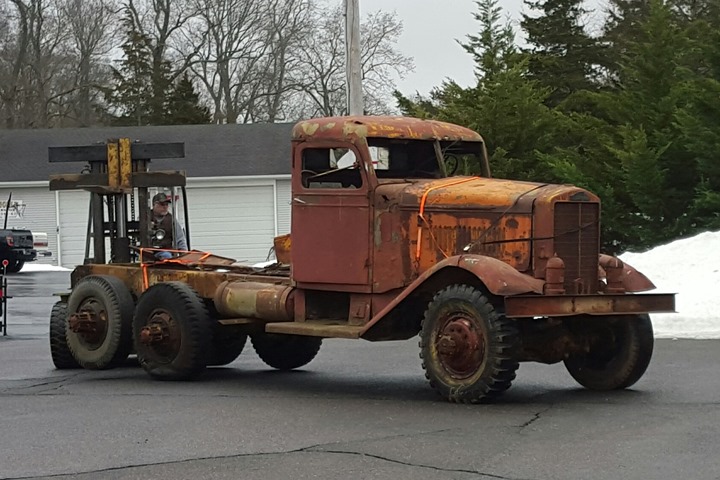
This image shows the second F-1 with the
hood and cowling on the truck. Photo courtesy of Jeff Lakaszcyck.
P-1 Crane Trucks:
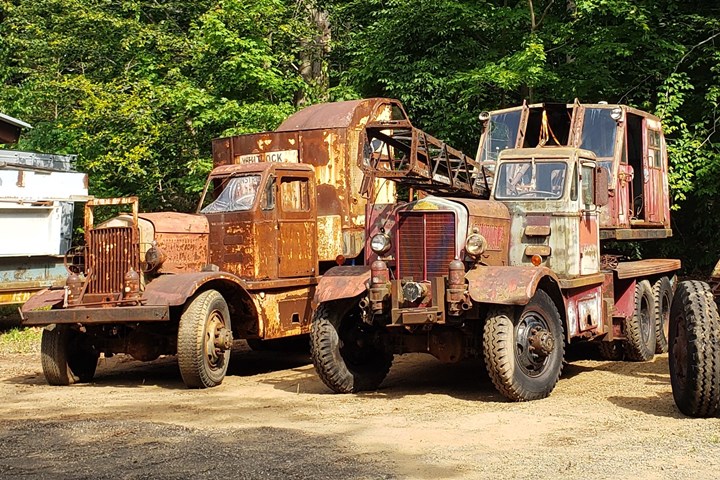
Mr. Ken Ochenkowski also owns two Biederman
P-1 crane trucks. In this photo, both trucks are shown together at
Mr. Ochenkowski's facility. Warren Richardson photo via Jeff Lakaszcyck
added 10-10-2023.
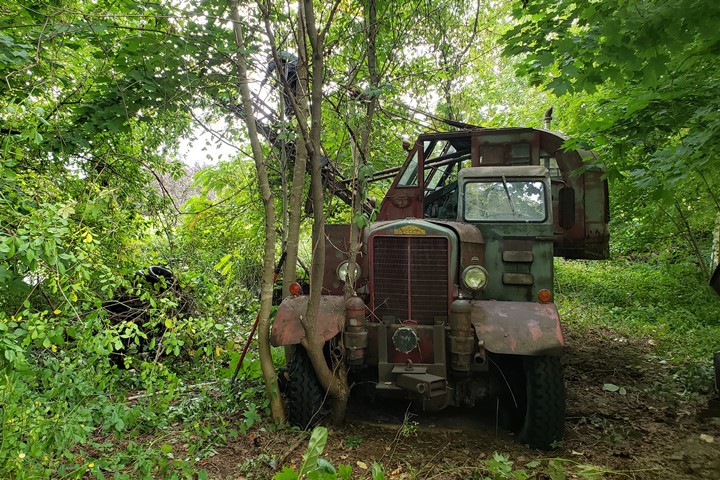
This is a
view of the same P-1 crane truck that was on the right in the above
photo before it was removed from the woods and loaded onto the low-boy
trailer shown below. Photo courtesy of Warren Richardson added
10-10-2023.
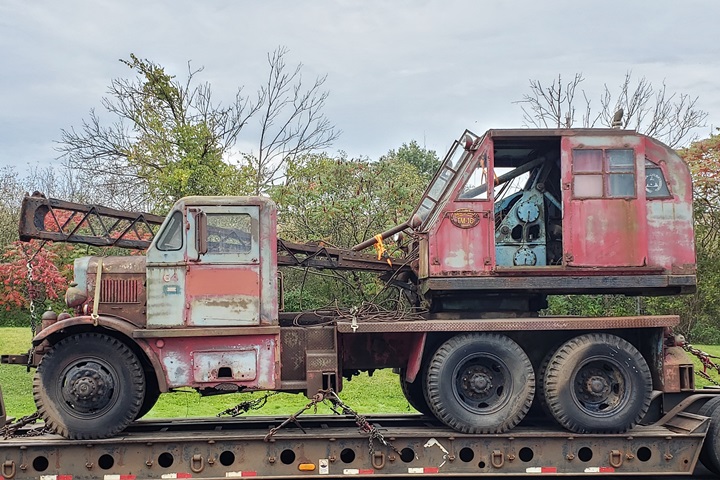
Photo courtesy of Warren Richardson added
10-10-2023.
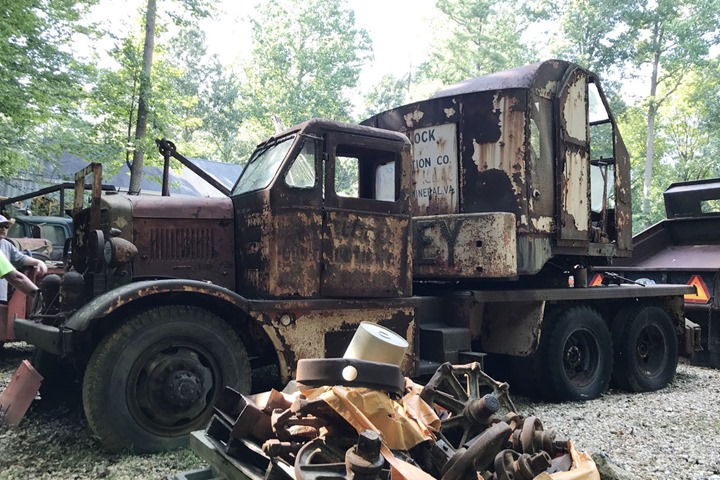
This 1945 P-1 crane truck is the one on the
left in the top photo of this section. Photo courtesy of Jeff Lakaszcyck.
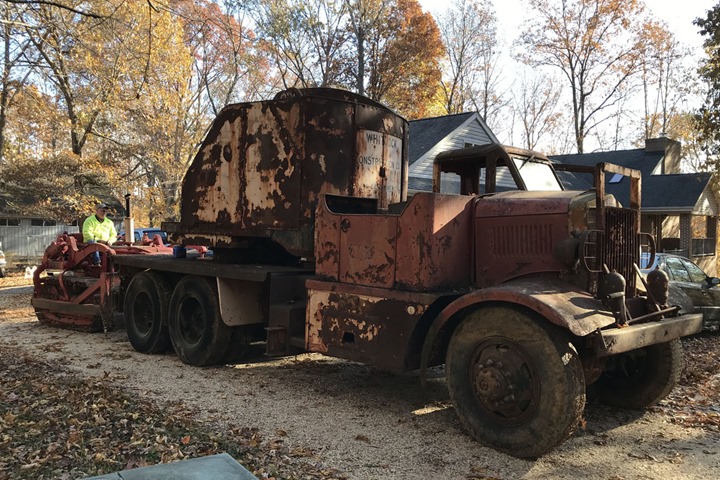
Photo courtesy of Jeff Lakaszcyck.
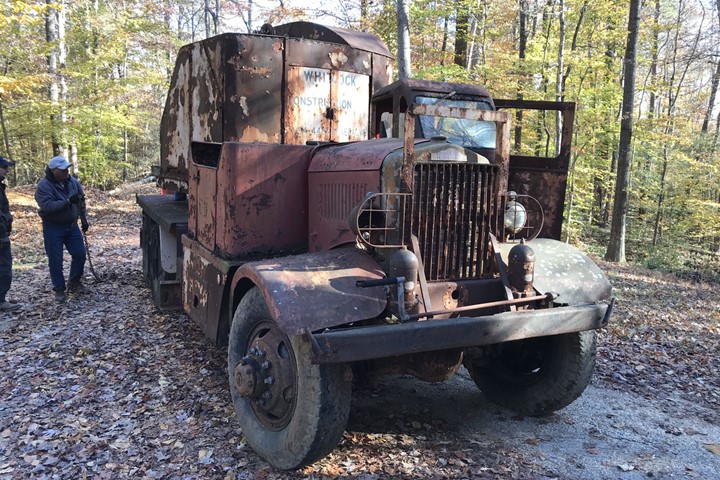
Photo courtesy of Jeff Lakaszcyck.
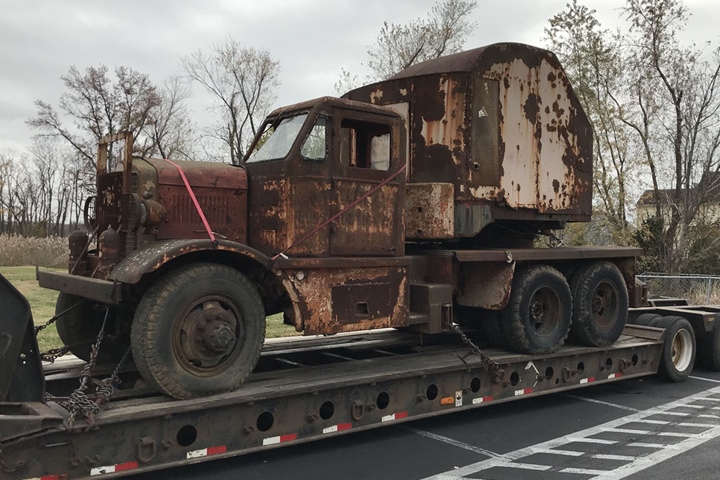
Photo courtesy of Jeff Lakaszcyck.
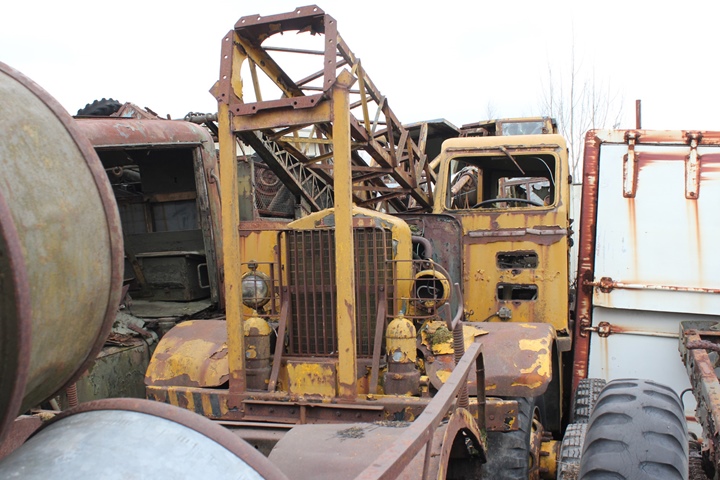
This Biederman P-1 was photographed in
Sweden. Photo courtesy of Sven Bengston via Jeff Lakaszcyck.
|



















































